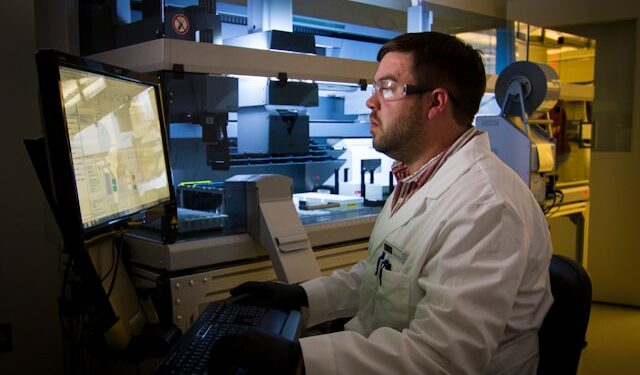Ipamorelin, a pentapeptide, has garnered considerable attention in the scientific domain due to its unique properties and potential in fields such as cellular regeneration, muscular development, and metabolic regulation. This peptide, which is primarily studied within the context of growth hormone (GH) secretagogues, is believed to exhibit a distinctive mechanism by selectively binding to GH secretagogue receptors without impacting other hormonal pathways significantly. Its structural simplicity, combined with its hypothesized receptor selectivity, distinguishes it from other peptides in similar research categories.
As research on Ipamorelin progresses, scientists have begun to explore its potential in supporting cellular repair, improving musculoskeletal integrity, and regulating metabolic processes. This article will examine Ipamorelin’s properties, its interaction with receptor pathways, and potential research implications, with an emphasis on its prospective contributions to various scientific domains.
Introduction to Ipamorelin and Its Mechanisms
Studies suggest that Ipamorelin, composed of five amino acids (Aib-His-D-2-Nal-D-Phe-Lys), may act by stimulating the release of growth hormone from the pituitary gland. This specific peptide is categorized as a GH secretagogue, designed to trigger GH release without strongly stimulating other neuroendocrine pathways. Structurally, Ipamorelin is unique as it is thought to selectively target growth hormone receptors, limiting off-target receptor interactions and potentially allowing for more refined applications in research contexts.
Potential Role of Ipamorelin in Cellular Research
One of the most compelling areas of Ipamorelin’s research focuses on cellular regeneration, particularly in the context of tissue repair and wound healing. Ipamorelin’s stimulation of GH release may suggest roles in promoting cellular division, protein synthesis, and regeneration across various tissues, particularly those that are highly responsive to GH. GH is considered to potentially promote the proliferation of certain cell types, such as fibroblasts and myoblasts, which play vital roles in repairing tissue following injury or wear.
Muscular Research on Anabolic Processes
Ipamorelin’s potential applications in musculoskeletal development form another promising avenue for scientific inquiry. In muscle physiology, GH is believed to play a critical role in supporting anabolic processes, which involve the buildup of complex molecules from simpler ones to support tissue growth. Research suggests that Ipamorelin, by facilitating GH secretion, may promote protein synthesis and muscle tissue repair, which are both integral to muscular growth.
Researchers have hypothesized that Ipamorelin might be useful for experiments focusing on muscle-wasting conditions, including those related to aging or immobilization. These experimental models aim to understand how GH-mediated processes might mitigate muscle catabolism and promote tissue recovery. Investigations purport that by potentially encouraging a balance between anabolic and catabolic pathways, Ipamorelin could serve as a tool in studies exploring ways to optimize muscle integrity and strength under conditions of stress or recovery.
Metabolic Research and Potential Roles in Lipid and Glucose Homeostasis
Metabolic research represents a third promising domain for Ipamorelin exploration, particularly given GH’s involvement in lipid and glucose metabolism. Ipamorelin’s potential to stimulate GH release has prompted researchers to consider its implications for metabolic regulation. GH plays a central role in lipolysis, the breakdown of fats into free fatty acids, which may then be utilized as an energy source. Findings imply that Ipamorelin could be applied in research models exploring lipid metabolism, where the peptide might induce the mobilization of fatty acids from adipose tissue for metabolic processes.
Exploring Ipamorelin in Neurobiology and Cognitive Research
An emerging area of interest in Ipamorelin’s research relates to neurobiology, particularly in GH’s potential roles in cognitive integrity and neuroprotection. Investigations have started to examine whether Ipamorelin, through GH stimulation, may indirectly impact neurogenesis, the process by which neurons are generated from neural stem cells. The brain’s ability to generate new neurons is central to cognitive resilience and recovery from injury, leading researchers to speculate that Ipamorelin might be valuable in models focused on brain integrity and cognitive function.
Bone and Cartilage Research
Ipamorelin’s potential impact on bone density and cartilage preservation offers yet another promising research frontier. GH is integral to bone turnover and development, as it influences osteoblasts, the cells responsible for bone formation. Scientists speculate that Ipamorelin’s stimulation of GH release has led scientists to hypothesize that it may contribute to an increased rate of bone cell proliferation and collagen synthesis, essential for both bone strength and cartilage integrity.
Conclusion
Ipamorelin, with its unique properties as a GH secretagogue, is thought to offer a wide array of research implications across various scientific disciplines. Its selective mechanism of stimulating GH release without significant off-target activity presents a versatile tool for exploring cellular regeneration, muscular development, metabolic regulation, neurobiology, and skeletal integrity. While further investigation is required to fully elucidate its mechanisms and potential impacts, Ipamorelin represents a promising avenue for advancing our understanding of peptide-based research in a controlled and highly specific manner. With ongoing studies, Ipamorelin might soon provide researchers with new insights into the regulation of fundamental physiological processes, potentially paving the way for novel discoveries in bioscience and beyond. Visit Core Peptides for the best Ipamorelin peptide for research.
References
[i] Davenport, M. L., Preece, M. A., & Hindmarsh, P. C. (1990). The role of growth hormone in bone and cartilage development: Clinical and experimental perspectives. Journal of Endocrinology, 124(2), 293–299. https://doi.org/10.1677/joe.0.1240293
[ii] Anderson, R. H., Lee, W. S., & Birch, N. P. (2016). Neurotrophic factors and the potential for growth hormone in neurogenesis. Frontiers in Endocrinology, 7, 21. https://doi.org/10.3389/fendo.2016.00021
[iii] Lee, P. D. K., Conover, C. A., & Powell, D. R. (1993). Regulation and function of insulin-like growth factor-binding protein-1. Proceedings of the Society for Experimental Biology and Medicine, 204(1), 4–29. https://doi.org/10.3181/00379727-204-43654
[iv] Froiland, K., Gracia, A., Huang, D., & Butterfield, T. A. (2014). Role of growth hormone in muscle repair and remodeling. Current Opinion in Clinical Nutrition and Metabolic Care, 17(3), 199–204. https://doi.org/10.1097/MCO.0000000000000050
[v] Ghigo, E., Arvat, E., Gianotti, L., & Camanni, F. (1998). Growth hormone-releasing peptides. European Journal of Endocrinology, 139(6), 525–531. https://doi.org/10.1530/eje.0.1390525
Do you have a story in your community or an opinion to share with us: Email us at editorial@watchdoguganda.com














